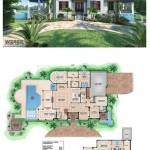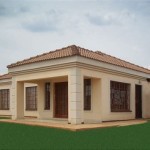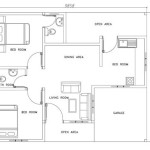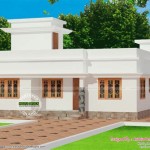Open Floor Plan Designs: A Comprehensive Overview
Open floor plan designs have gained substantial popularity in residential and commercial architecture over the past few decades. This architectural style involves the combination of multiple traditional rooms into a single, larger space. Typically, this means removing or minimizing walls between the living room, dining room, and kitchen. The goal is to create a more expansive, flexible, and interconnected living or working environment.
The shift towards open floor plans reflects evolving lifestyles and preferences. Modern living often emphasizes social interaction, transparency, and adaptability. Open floor plans cater to these needs by fostering a sense of togetherness and allowing for a greater flow of natural light and movement throughout the space. However, this design choice also presents considerations regarding noise control, privacy, and spatial definition.
Understanding the various aspects of open floor plan designs is crucial for architects, designers, and homeowners alike. This article will examine the key benefits and drawbacks, explore design considerations, and offer practical tips for creating successful and functional open floor plan layouts.
Benefits of Open Floor Plans
Open floor plans offer numerous advantages that contribute to their appeal and popularity. These benefits range from enhanced social interaction to improved natural light distribution.
One of the primary benefits is enhanced social interaction. By eliminating walls between common areas, open floor plans facilitate easy communication and connection between individuals engaged in different activities. This is particularly advantageous for families with young children, as parents can supervise children playing in the living room while preparing meals in the kitchen. Similarly, when entertaining guests, an open floor plan allows the host to interact with visitors while simultaneously managing food and beverages.
Another significant advantage is the increased flow of natural light. Walls often obstruct the passage of sunlight, leading to darker and more isolated spaces. Open floor plans, by removing these barriers, allow natural light to penetrate deeper into the interior, creating a brighter and more welcoming atmosphere. This can also lead to energy savings, as less artificial lighting is required during the day. The improved natural light can also positively impact mood and overall well-being.
Open floor plans can also contribute to a greater sense of spaciousness. Even in smaller homes or apartments, removing walls can create the illusion of a larger, more open area. This is particularly beneficial in urban environments where space is at a premium. The visual expansion can also make a space feel less cluttered and more airy.
Flexibility and adaptability are further advantages. Open floor plans offer a blank canvas for homeowners to customize and reconfigure the space according to their evolving needs. Furniture arrangement and décor can easily be changed to accommodate different activities or events. This adaptability is especially valuable in modern households where lifestyles are dynamic and priorities shift over time. The adaptability also allows for future modifications and renovations with greater ease.
Drawbacks of Open Floor Plans
Despite their numerous advantages, open floor plans also present certain challenges that must be carefully considered. These drawbacks relate to noise control, privacy, and the lack of distinct spatial separation.
One of the primary concerns is noise control. In an open floor plan, sounds from the kitchen, living room, and dining area can easily travel and merge, creating a noisy and distracting environment. This can be particularly problematic when individuals are trying to focus on work, study, or relax. The lack of sound barriers can also make it difficult to hold private conversations or enjoy quiet time. Effective soundproofing measures, such as acoustic panels and sound-absorbing materials, may be necessary to mitigate this issue.
Privacy is another significant concern. The absence of walls reduces the sense of separation between different activities and individuals. This can be problematic for family members who desire personal space or need to engage in activities that require privacy, such as working from home or attending virtual meetings. Creating dedicated nooks or utilizing partial walls can help address this privacy issue without completely sacrificing the open concept.
The lack of distinct spatial separation can also be a drawback. Without clearly defined rooms, an open floor plan can sometimes feel disorganized and chaotic. This can make it difficult to establish designated zones for different activities, such as cooking, dining, and relaxing. Careful planning and furniture arrangement are crucial to create a sense of order and structure within an open floor plan.
Heating and cooling efficiency can also be impacted. Open spaces often require more energy to heat or cool compared to traditionally divided homes. The lack of interior walls means that conditioned air can easily escape, leading to higher energy bills. Implementing energy-efficient windows, insulation, and HVAC systems can help minimize this issue.
Design Considerations for Open Floor Plans
Effective design is paramount to creating a successful and functional open floor plan. Careful planning and attention to detail are necessary to maximize the benefits and mitigate the potential drawbacks.
Defining zones is crucial. Although the space is open, it is important to establish distinct zones for different activities, such as cooking, dining, and relaxing. This can be achieved through furniture arrangement, area rugs, changes in flooring material, or the use of partial walls or screens. Defining zones helps create a sense of order and organization within the open space.
Furniture selection and placement play a significant role. Furniture should be chosen to complement the open layout and define different zones. Sectional sofas, large area rugs, and strategically placed bookshelves can help visually separate different areas without completely blocking the flow of space. The scale and style of furniture should be consistent throughout the open area to create a cohesive and harmonious look.
Lighting design is also essential. A well-designed lighting scheme can enhance the ambiance and functionality of an open floor plan. A combination of ambient, task, and accent lighting can be used to create different moods and highlight specific features. Pendant lights over the kitchen island, recessed lighting in the ceiling, and floor lamps in the living area can all contribute to a balanced and versatile lighting scheme.
Storage solutions are particularly important in open floor plans. Since there are fewer walls for built-in storage, it is crucial to incorporate creative and functional storage solutions. This can include utilizing vertical space with tall shelving units, incorporating storage ottomans or benches, and integrating hidden storage compartments into furniture. Maximizing storage helps keep the open space clutter-free and organized.
Consideration should be given to the flow and circulation within the space. The layout should facilitate easy movement between different zones without creating bottlenecks or obstacles. Pathways should be wide and unobstructed, allowing for comfortable and efficient circulation. Attention to ergonomics and accessibility is also important.
Finally, personal style and preferences should be incorporated into the design. An open floor plan provides an opportunity to express individual taste and create a space that reflects the homeowner's personality and lifestyle. Color palettes, artwork, and decorative accents can all contribute to a unique and personalized open floor plan.
By carefully considering these design aspects, architects, designers, and homeowners can create open floor plans that are both aesthetically pleasing and functionally efficient, maximizing the benefits of this popular architectural style while minimizing its potential drawbacks.

House Design Trends What S Popular In Cur Floor Plans Extra Space Storage

Pros And Cons Of An Open Concept Floor Plan Generation Homes Nw

30 Gorgeous Open Floor Plan Ideas How To Design Concept Spaces
:max_bytes(150000):strip_icc()/1660-Union-Church-Rd-Watkinsville-Ga-Real-Estate-Photography-Mouve-Media-Web-9-77b64e3a6fde4361833f0234ba491e29.jpg?strip=all)
18 Open Floor House Plans Built For Entertaining

How To Decorate Your Open Floor Plan Like A Pro Interior Design Home Staging Jacksonville Fl Interiors Revitalized

Make The Most Of Your Open Floor Plan Design Certified Title Corp

Filling The Space 8 Interior Design Tips For An Open Floor Plan Fusion Furniture Inc

The History Of Open Floor Design Interior Designers At Asheville S

Designing The Perfect Open Concept Floor Plan For Modern Living

Simple Design Ideas To Create An Outstanding Open Floor Plan Lita Dirks Co Award Winning Interior And Merchandising Firm








